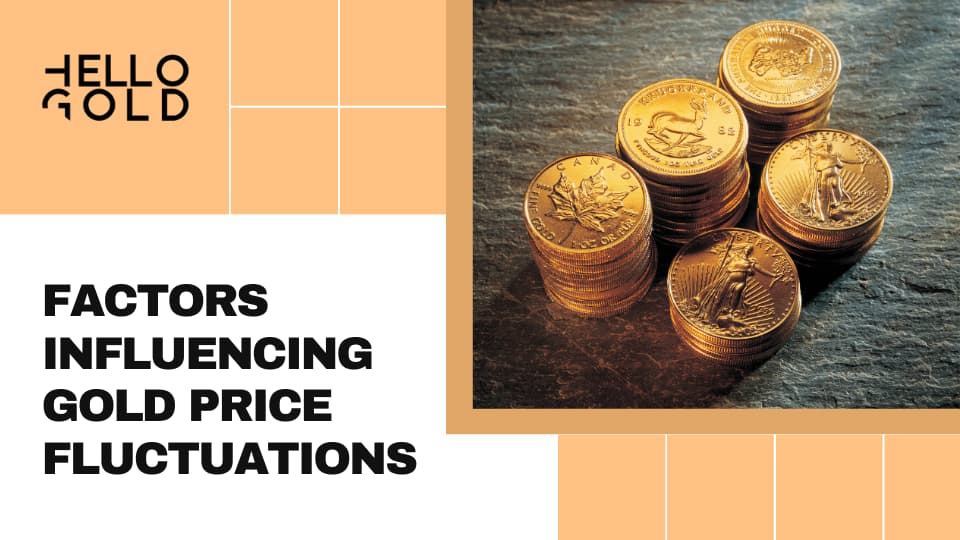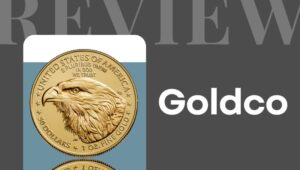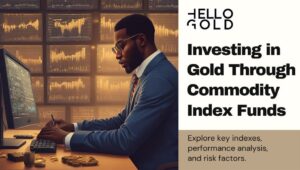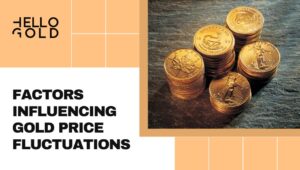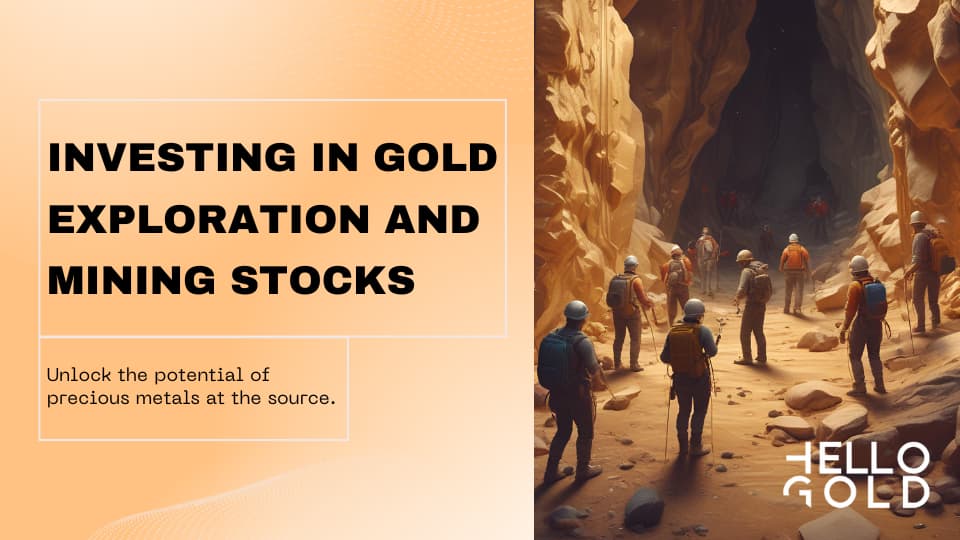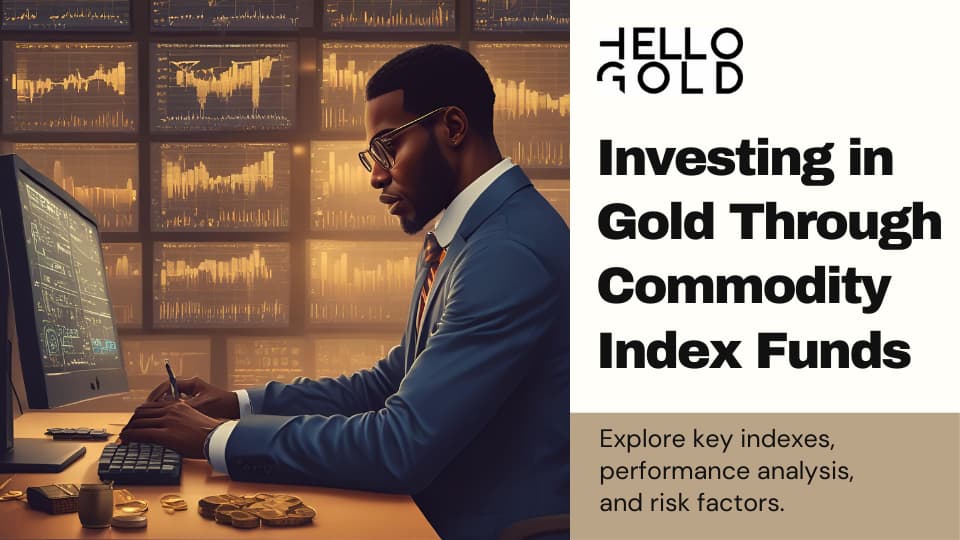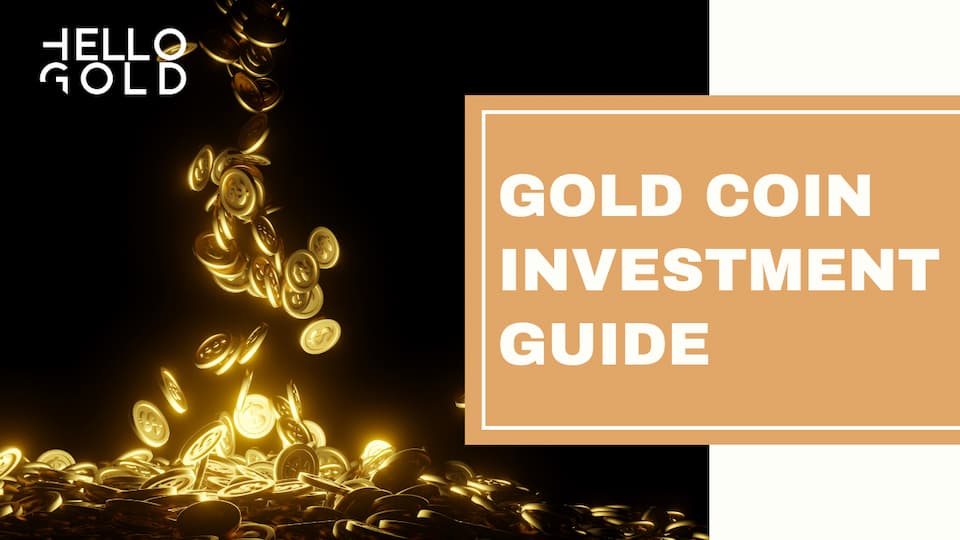Things like rising prices, interest rate changes, and currency value shifts drive gold prices.
Knowing these things helps you choose if gold should be part of your investment plan.
This article breaks down how these key forces impact the cost of gold, so you can make informed picks about adding this valuable metal to your portfolio.
Economic Factors Driving Gold Prices
Have you ever wondered what makes the price of gold go up and down? With so much uncertainty in the economy, it’s important to understand what affects the value of this precious metal. That way you can make informed choices when investing.
Three key economic forces – inflation, interest rates, and currency changes – play a big role in shaping gold prices. This article will break down how these factors impact gold.
That will help you see if gold should be part of your investment portfolio.
Inflation and Gold’s Role as an Inflation Hedge
Inflation is a key factor to consider when evaluating gold as an investment.
As the cost of living rises, the purchasing power of each dollar decreases. For example, an item that cost $1 in the past would likely have a significantly higher price tag today.
This is because inflation gradually erodes the value of money over time.
But here’s where gold really stands out: it has a proven history of not just holding its value during high inflation, but often going up in value.
In the inflationary 1970s, gold prices skyrocketed by a whopping 1,500%. At the same time, the U.S. dollar lost almost half its purchasing power.
More recently, gold prices hit an all-time high on April 9, 2024. This suggests investors see it as a safe haven when inflation is happening.
What makes gold so good at protecting against currency losing value and purchases costing more? There are some key reasons.
First, gold has built-in value as a tangible asset – it can’t be printed or manipulated like regular money.
Second, gold’s limited supply helps keep its value over time, as it gets more scarce.
And third, gold’s long history as a trusted way to store value makes it attractive during uncertain economies.
Investors want to protect their wealth.
Investors choose gold to safeguard against the erosion of currency value and inflation diminishing purchasing power for good reasons.
Gold has its own inherent worth as a physical asset that can’t be artificially generated or tampered with like regular currencies. Also, gold’s finite supply helps it retain its worth as it becomes increasingly rare.
Finally, gold’s long use as a trusted store of value makes it reliable when economies are uncertain. Investors seek to protect their wealth from inflation’s corrosive effects.
Interest Rates and the Opportunity Cost of Holding Gold
Interest rates are another big piece of the gold price puzzle.
As an asset that doesn’t earn interest, gold’s value often moves opposite to interest rates.
When rates fall, the opportunity cost – or trade-off – of holding gold instead of interest-earning investments like bonds goes down.
That makes gold more appealing.
If the Federal Reserve aggressively lowered rates to stimulate the economy during a downturn, the opportunity cost of owning gold would lessen.
In this scenario, investors may rush to the precious metal as a safe haven. Gold’s reduced holding expense could increase demand and drive up its price.
As an investor, it’s key to grasp this flip-flop relationship between interest rates and gold prices.
When rates drop or are expected to fall, the cost of not investing in gold diminishes. That makes it a more interesting addition to your portfolio.
By keeping an eye on rate trends and forecasts, you can make smart decisions about when to allocate more to gold.
Lower interest rates often happen alongside slowing economies, expectations of higher inflation, and demand for safe assets like gold.
On January 17, 2024, J.P. Morgan predicted gold prices peaking at $2,300/oz in 2025 due to Fed rate cuts and falling U.S. real yields.
This shows the huge impact rate expectations can have on gold.
As an investor, knowing the flip-flop relationship between rates and gold prices can assist you in determining the opportune moments to bolster your gold holdings. When rates decline or show signs of decreasing, the opportunity cost of holding gold shrinks, making it more appealing to invest in.
Currency Fluctuations and the U.S. Dollar’s Impact
Gold is mainly priced in U.S. dollars for world trade. That means the strength of the dollar significantly influences gold prices.
When the dollar weakens, gold gets cheaper for foreign buyers, increasing demand. On the other hand, a stronger dollar makes gold more expensive, potentially decreasing demand.
This is especially clear during times of dollar weakness.
Between December 2019 and August 2020, the U.S. Dollar Index dropped around 10%.
At the same time, gold prices rose by almost 30%.
This shows the inverse correlation between the dollar and gold prices.
As an investor, watching the strength of the U.S. dollar can provide valuable clues into potential gold price movements.
When the dollar loses value, gold becomes more appealing to foreign buyers, potentially pushing prices up. In contrast, a stronger dollar may lead to possible price declines.
By monitoring currency changes and grasping their impact on gold, you can make more strategic choices about buying or selling gold.
It’s worth noting that while the U.S. dollar is the main currency driving gold prices, changes in other major currencies like the Euro or Chinese Yuan can also sway global gold demand and pricing. For investors, grasping the entire currency landscape and its potential impact on gold investments is crucial.
The economic factors we’ve explored here – monetary policy, borrowing costs, and foreign exchange dynamics – form the foundation for grasping how gold prices are shaped by overall market conditions.
Next, we’ll look at how these factors interact with world events and economic uncertainty to create a complex and shifting landscape for gold investors.
Understanding how these forces connect will help you better navigate the always-changing world of gold investing. You’ll be able to make decisions that align with your long-term financial goals.
Geopolitical Events and Economic Uncertainty
As we’ve seen, economic factors like rising prices, shifting lending rates, and fluctuating currencies significantly impact gold prices.
However, global turmoil and financial instability can also greatly affect the worth of this lustrous commodity.
During turbulent times, investors often turn to gold as a safe haven asset to protect their wealth.
Building on this foundation, let’s now closely examine how gold has done in the past during crises, the importance of diversification, and potential future risks that could drive demand for gold. Grasping these factors is key for making informed choices about incorporating gold into a balanced investment portfolio.
Historical Examples of Gold Price Increases During Crises
To truly understand gold’s role as a safe haven, it’s essential to look at how it performed during some of the biggest crises of the past 50 years. Let’s review a few major examples:
1. 1970s Oil Crisis: The 1973 oil embargo and resulting energy crisis introduced the idea of ‘energy efficiency’ into everyday language. This led to big changes in various sectors focused on reducing energy use and costs.
2. Gulf War (1990): While I can’t confirm the exact gold price change during Iraq’s invasion of Kuwait in August 1990, evidence shows geopolitical events can greatly impact prices. The Gulf War spotlighted air power and joint military efforts, potentially indirectly influencing gold prices due to uncertainty.
3. 9/11 Terrorist Attacks (2001):
The tragic September 11th attacks caused a global flight to safety.
One study of gold price volatility around major world events between January 1979 and March 2020 identified six key dates tied to huge historical happenings impacting prices.
The research showed much higher volatility spikes during disasters like the 2001 US terrorist attacks.
4. 2008 Financial Crisis: As the global financial system was on the edge of collapse, investors rushed to gold in droves. Gold ETF holdings grew 30.5% in 2020, pointing to strong investor demand during economic uncertainty.
5. Brexit Referendum (2016): The unexpected vote for the UK to leave the European Union in June 2016 shocked global markets. Even accounting for other factors, geopolitical events significantly sway gold returns.
These examples demonstrate how increased economic and geopolitical uncertainty can drive major demand for gold, resulting in huge price spikes and more money flowing into gold-related investments. As an investor, comprehending these historical patterns is crucial for making well-informed decisions about protecting your portfolio during turbulent times.
Gold’s Low Correlation to Other Assets During Turmoil
One of the main reasons investors choose gold during uncertain times is its low correlation to other assets like stocks and bonds. Correlation measures how two assets move in relation to each other, with 1 meaning they move together, -1 meaning they move oppositely, and 0 meaning no correlation.
In my experience, gold has consistently shown low or even negative correlation to stocks and bonds during market slumps.
Research shows the correlation between gold and stocks is weakly negative from 1987 to 2020.
This means as stocks drop, gold prices generally climb.
By adding an uncorrelated asset like gold to your portfolio, you can potentially decrease overall volatility and protect against big losses. According to the World Gold Council, having 2.5% to 9.0% gold in investment portfolios can lead to lower risk while maintaining comparable returns to portfolios without gold.
This diversification benefit is especially important during economic and geopolitical uncertainty when conventional investments may be extra volatile. Including gold in your portfolio can potentially smooth out returns and safeguard your wealth when times are rocky.
Future Geopolitical Risks and Potential Impacts on Gold
Looking ahead, several concerning geopolitical risks could potentially drive safe haven demand for gold. Some include:
1. U.S.-China Tensions: The ongoing trade dispute and political tensions between the U.S. and China could create economic uncertainty and lift gold demand. If relations between the two continue worsening, it could significantly impact the global economy and markets, potentially causing a gold price surge.
2. Middle East Instability: Continued conflicts and political instability in the Middle East, especially in countries like Iran and Syria, could lead to higher risk premiums and increased gold prices. A major escalation in Middle East tensions could disrupt global oil supplies and generate widespread economic uncertainty, driving investors to the safety of gold.
3. Russian Conflicts: The ongoing conflict between Russia and Ukraine, and tensions between Russia and Western nations, could result in economic sanctions and increased geopolitical risk. A major escalation in the Russia-Ukraine conflict could have far-reaching economic consequences, potentially driving investors to seek the stability and security of gold investments.
Even without outright conflict, rising geopolitical tensions can push gold prices up as investors look to hedge against uncertainty. Gold prices are projected to hit fresh highs in 2024, averaging $2,150/oz in Q4 and $2,081/oz for the full year.
As an investor, staying up-to-date on global happenings and grasping how they can sway gold prices is essential for making wise decisions regarding portfolio diversification and risk management. By including gold in your portfolio and keeping an eye on potential risks, you can navigate uncertain times with greater confidence and protect your wealth for the long haul.
While we can’t predict the future perfectly, understanding historical patterns and potential risks can assist us in making smarter decisions about positioning our portfolios. By adding gold as part of a balanced investment approach, we can potentially reduce the impact of worldwide upheaval and economic uncertainty on our wealth.
As always, it’s important to consider your specific financial goals, risk tolerance, and timeframe when investing. But for those looking to protect and grow their wealth in an increasingly uncertain world, gold remains an interesting option to consider.
Supply and Demand Dynamics of the Gold Market
Building on the economic and political factors discussed earlier, it’s crucial to examine the complex interplay of supply and demand in the gold market. these forces significantly impact gold prices and can greatly affect investment choices for those looking at gold as part of their alternative investment approach.
To truly understand the intricacies of the gold market, we need to grasp the roles of key players like miners, central banks, and different types of investors.
By analyzing how these groups influence supply and demand, we can gain valuable insight into what’s driving gold prices and make more informed decisions when putting funds into this precious metal.
As we go on, we’ll examine the specific impact of each of these important players, giving you a complete picture of how the gold market works.
Annual Gold Mine Production and Impact of Rising Costs
First up, we have the hardworking people who actually pull the precious metal out of the ground – gold miners.
You might think that when gold prices rise, miners can simply ramp up production and flood the market with more gold. But it’s much more complicated than that.
Global gold production doesn’t fluctuate much year to year. As per the authoritative data from the World Gold Council, total gold supply in 2023 grew 3% compared to the previous year because of increased mine supply and recycling.
But annual mine production only went up 1%, hitting its highest point since 2018.
Most new gold mined annually basically replaces gold from tapped out mines, rather than dramatically expanding the total supply.
Plus, miners are dealing with growing cost pressures nowadays. Ore grades are getting worse, forcing them to dig up more rock to get the same amount of gold. Energy costs are rising, and lots of new environmental and social regulations have appeared.
All these things make mining gold increasingly tough and expensive, which can actually help prop up prices by limiting miners’ ability to quickly raise production.
Let’s look at some statistics from the leading authority on gold.
Gold production costs hit a record high of $1,276/oz in 2022, an 18% year-over-year jump.
Average all-in sustaining costs in gold mining increased 1% from the previous quarter in Q3 2022, reaching a new record of $1,289/oz.
This is largely because miners are facing major obstacles around costs and regulations.
It’s a challenging time to be a gold miner, but oddly enough, this can be good news for investors banking on higher gold prices.
Central Banks as Major Gold Buyers and Sellers
Next, we have the heavy hitters of the gold market – central banks. These institutions hold the largest official gold reserves, and their moves can create shockwaves in the market.
After the 2008 financial crisis, central banks went on a gold-buying binge, aiming to diversify their reserves and reduce reliance on the mighty U.S. dollar. This trend has been a major support for gold prices in recent years.
When a major central bank like China’s or Russia’s announces a big gold purchase, it sends a powerful message to the market and can spark a price surge.
As of 2024, the top five official gold holders are the U.S., Germany, Italy, France, and Russia.
For investors considering gold, watching central bank activity closely is essential.
Let’s look at the staggering numbers from recent years. Central bank purchases hit record levels in 2022 with 1,083 metric tons, followed by another 387 metric tons in the first half of 2023.
The World Gold Council found central bank buying kept momentum in Q4 2023, adding 229 tonnes to global official gold reserves, driven by concerns over possible sanctions on foreign assets.
China and Poland were major buyers in 2023, snapping up 225 tonnes and 130 tonnes. That’s a massive amount of gold removed from the market, playing a huge role in pushing prices up.
For those looking to invest, it’s crucial to monitor these significant central bank movements, as they have the potential to dramatically alter the trajectory of the gold market.
Trends in Retail and Institutional Investor Demand
Central banks aren’t the only ones fueling demand for gold. Regular investors like you and me play a big role too, whether buying physical gold coins/bars or trading gold ETFs and futures contracts.
Over the past decade, gold ETFs have exploded in popularity, pointing to surging interest from institutional investors.
When these big players start pouring cash into gold ETFs, it can tangibly impact short-term price movements, serving as a gauge of sentiment towards gold at any given moment.
At the same time, growth in gold futures and options markets has strengthened gold’s ties to the broader financial system, which can magnify short-term price volatility.
It’s all part of the exciting ride when investing in gold!
For investors, grasping the nuances of gold demand and how they can sway prices is crucial.
Retail demand for physical gold tends to be more stable and less reactive to short-term price changes, while institutional demand can shift more easily based on broader market trends.
Global gold ETFs lost $823 million in March 2024, but outflows narrowed a lot compared to previous months due to inflows into North America and Asia.
By monitoring both types of demand, you can get a clearer sense of where the gold market is headed.
Evolving Demand from Emerging Markets and Demographics
We can’t overlook the growing middle class in countries like China and India.
As wealth increases in these nations, so does appetite for gold jewelry and bars, both as fashion and a way to save and protect wealth.
In these cultures, gold is deeply ingrained in society, symbolizing status and financial security.
China and India already rank among the world’s biggest gold consumers, making up a large portion of global consumer demand.
As more people in these countries enter the middle class, long-term demand for gold is poised for major growth.
For investors, this demographic change makes a compelling case for gold as a long-term play, especially given potential currency issues and economic uncertainty in these regions.
Consider this: as the middle class expands in China and India, hundreds of millions of people can afford to buy gold jewelry and investments for the first time.
This represents huge new demand that could drive gold prices up over the long run. Moreover, with the threat of economic and political instability looming in these regions, more people will likely seek refuge in gold as a secure store of value for their wealth.
The supply and demand forces in the gold market are a complex and fascinating web of interconnected dynamics. By grasping the roles of miners, central banks, retail and institutional investors, and the rising middle class in emerging markets, you’ll be better positioned to make informed calls on if and how to add gold to your investment approach.
Trends in the Gold Market
Several key trends are reshaping the gold market and bringing new opportunities for investors.
Grasping the implications of these trends is vital for making informed choices and effectively adding gold to a balanced investment plan.
As we examine each trend closely, we’ll uncover how they are changing how investors approach gold and what steps you can take to benefit from these shifts. By staying up-to-date and adapting to the evolving landscape, you’ll be in a better spot to identify promising opportunities and navigate the dynamic gold investing world.
Technological Advancements and Their Impact
First up, let’s discuss the game-changing potential of blockchain technology in the gold market.
This innovative tech is revolutionizing how we buy, sell, and trade gold, offering accessibility and transparency that was once unthinkable.
With tokenization, you can now own a fraction of a gold bar, making it easier to invest in this precious metal without breaking the bank.
Companies like Paxos and Tether already offer gold-backed digital tokens, giving investors a more flexible and liquid way to gain exposure to gold.
But blockchain’s benefits don’t stop there. It’s also tackling growing concerns around ethical sourcing in gold.
By using blockchain, we can ensure traceability of gold from mining to refining, creating a transparent record of a gold product’s journey from mine to market.
The World Gold Council has even launched “Responsible Gold Mining Principles,” showing the industry’s commitment to sustainable and responsible practices.
As an investor, keeping up with these tech advancements is crucial. They’re not just opening new investment avenues but also changing how we think about gold investing overall.
Environmental, Social, and Governance (ESG) Factors
Next, let’s look at ESG factors. These environmental, social, and governance considerations are becoming more and more important for investors, and gold is no exception.
Gold mining practices are facing increased scrutiny for their environmental impact, including deforestation, habitat disruption, and water contamination. Per the World Gold Council, gold mining contributes about 0.4% of annual global greenhouse gas emissions, mostly through electricity use during mining operations.
Emissions from gold mining come predominantly from direct energy use and indirect electricity consumption, making up around 36% and 43% respectively of the industry’s total carbon footprint. That’s a significant portion, which is why ESG focuses on pushing sustainable mining and minimizing ecological damage.
But here’s the thing: as an investor, you have power to make a difference. By choosing to invest in gold mining companies that prioritize ESG practices, you’re not only supporting a more sustainable future for the industry but also potentially gaining from their long-term success.
Leaders like Newmont and Barrick Gold are setting ambitious goals for reducing their environmental impact, like cutting water use, emissions, and land disturbance. They’re also implementing responsible reclamation to restore mined areas.
By aligning investments with these companies, you’re signaling sustainability matters and you’re in it for the long run.
Regulatory Changes and Their Potential Impact
Lastly, let’s discuss regulatory changes and how they can affect your gold investments.
It’s vital to stay informed on modifications to mining practices, taxes, or environmental standards, as they can significantly impact the gold market.
For instance, if a major gold-producing country introduced a new tax on gold exports, it could temporarily slow that country’s gold sales, influencing global supply and demand.
As an investor, monitoring regulatory shifts is essential.
Changes to capital gains taxes on gold or adjustments to import and export duties can impact the profitability and appeal of gold as an investment.
For example, if a country announces stricter environmental rules for mining, it may affect gold supply and pricing, changing your strategy.
By keeping up with these regulatory moves and adjusting accordingly, you can better navigate the constantly changing gold market landscape. It’s all about being proactive, informed, and ready to adapt.
The gold market is dynamic and constantly evolving, shaped by powerful forces like tech, environmental/social factors, and regulation.
By grasping these trends and their implications, you can position yourself advantageously and seize new opportunities in alternative investing.
Whether it’s leveraging blockchain for more accessible and transparent gold ownership, matching investments to ESG values, or navigating regulatory impacts, staying informed is vital for success in the captivating realm of gold.
Final Thoughts
You’ve seen how economic factors, world events, supply and demand, and market trends impact gold prices.
To make good choices about putting money into gold, watch inflation, interest rates, and currencies. Keep track of worldwide uncertainty that could increase safe haven demand.
Follow what central banks, miners, and different types of investors are doing. Stay current on tech advancements, environmental and social issues, and rule changes.
Think about your money goals and willingness to take risks to see if gold belongs in your portfolio. Consider getting advice from a money pro to make a plan just for you.
Stay informed as the gold market changes so you can make moves to grow your wealth over time.

